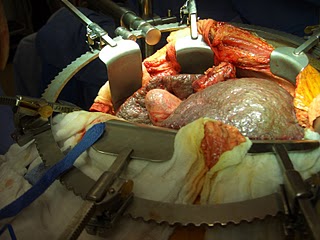
Liver transplant is the treatment choices for patients who suffer from liver failure without other co Pathological diseases. Currently, the only limiting factor during liver transplantation is not the presence of living or cadaveric donors to meet demand. Estimated that more than 17,000 Americans each year require a liver transplant, but only 5000 will be able to pass surgery due to the inconsistency of supply and demand.

The surgical technique will require a total removal of the liver and positioning of the donor liver in the same place followed by re-vascularization procedures. Being highly vascular structures, liver transplantation may give rise to many complications. Thus the performance of surgery, he would be only part of the success and many other factors have to come to the right in order to be a complete success of transplantation.
Therefore, we look at some of the complications that can occur after liver transplantation.
1. Rejection. Like other editorial in the human body, a liver transplant will also have to deal with their own bodies immune mechanisms in order to survive. As persons liver is not able to do so, he self, the external administration of immune suppression therapy will be indicated in these patients. Rejection can occur at any time and often failure occurs after several days of the week. Was recorded even after 1 year following transplantation and these are called chronic rejection failures. Symptoms of such a waiver will be similar to liver failure and results of laboratory liver enzymes would show a gradual rise.
2. Bleeding can be a higher chance of bleeding after the surgery and many vascular structures will be processed in the process. Hepatic artery, portal vein, all lower-quality vena cava can lead to complications, including bleeding from these sites. Close observation of these patients is vital and blood pressure, pulse rate, respiration, urine output, as well as other local symptoms would be useful in assessing the condition of patients.
3. Infections despite the fact that many of the precautions taken to avoid any infections, there is a remote possibility of burning the infection especially after the initiation treatment of immune suppression. Thus, these patients are treated with antibiotics as a prevention method for preventing such infections.
4. Fluid collections after the operation, it is common to fluid collection near the diaphragm and it can sometimes be a hematoma, and. Thus the need for close observation and it is usually allowed by their own as the drainage system will place after the operation.
5. Increased risk of malignant neoplasms in long-term use of immune suppression therapy was associated with a high risk of malignant neoplasms, more than the rest of the population.
Malignant: Medical Ethicists Confront Cancer
6. Arterial thrombosis and narrowing after surgery, and can develop after instrumentation stenosis may be the formation of thrombus in the hepatic artery. Both copies may jeopardize the safety of the newly displaced liver differently could lead to life-threatening conditions.
In addition to these complications, depending on the condition of patients, as well as the nature of the disease can be presented with a few other complications that timely interventions can be corrected.
For more info, get advice from doctor and expertise nearest.

Leave a Reply